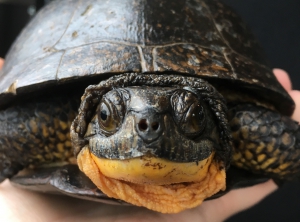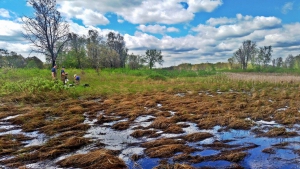
The first week of Blanding’s turtle work has been fun, hard, hot, cold, wet, and awesome. We have had a great time getting to know the wildlife biologists and techs we will be working with throughout the 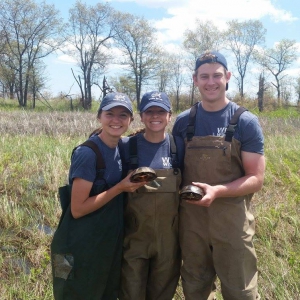 summer, and getting settled into our new roles as part of this collaborative team. Every day has been filled with acquiring new skills both in the field and the lab under the instruction of turtle guru and lab mate, Marta Rzadkowska. We have started to establish a daily routine for the summer that can be described in two components:
summer, and getting settled into our new roles as part of this collaborative team. Every day has been filled with acquiring new skills both in the field and the lab under the instruction of turtle guru and lab mate, Marta Rzadkowska. We have started to establish a daily routine for the summer that can be described in two components:
Field Work
We start each day by meeting at the turtle building and then heading out with a team of biologists to one of a few different field sites that we are evaluating. The biologist team locates turtles with three main techniques: aquatic basket traps, telemetry and transmitters, and of course by incidental encounters (we will explain these in more depth in a future blog). We follow the biologists as they check their traps to see if any Blanding’s turtles were caught and if we find a Blanding’s then we go to work. Shell dimensions, animal weight, and other demographic measurements are evaluated and recorded by the biologist team. A unique shell marking system is used to allow individual turtles to be identified and continuously monitored. Each turtle is then passed on to us so that we can evaluate the overall health. Blood collection, DNA swabs and physical exams are performed on every individual. To obtain blood from a 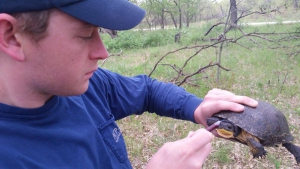 turtle, we stick between the head and carapace with a sterile needle to collect blood from a network of vessels called the “subcarapacial sinus.” Although a blind stick, usually this sinus is not too difficult to find. It can however become difficult when a turtle gets particularly feisty and thrashes their head and limbs around. We collect blood in three tubes to use for plasma, CBC and PCR tests. After drawing blood, we have to find a way to get a cotton swab into their mouth and cloaca to collect DNA. This part can be especially challenging because Blanding’s turtles are not known to bite and tend to be unwilling when it comes to opening their mouths. This step often
turtle, we stick between the head and carapace with a sterile needle to collect blood from a network of vessels called the “subcarapacial sinus.” Although a blind stick, usually this sinus is not too difficult to find. It can however become difficult when a turtle gets particularly feisty and thrashes their head and limbs around. We collect blood in three tubes to use for plasma, CBC and PCR tests. After drawing blood, we have to find a way to get a cotton swab into their mouth and cloaca to collect DNA. This part can be especially challenging because Blanding’s turtles are not known to bite and tend to be unwilling when it comes to opening their mouths. This step often 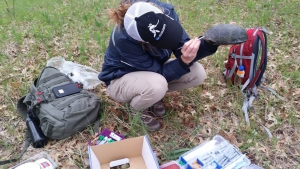 requires a lot of “hand holding” (literally, because this helps keep their head extended out of their shell) and gentle coaxing of probe pressure on the tip of their beaks. Finally, we perform a physical exam on the turtle by assessing attitude, eyes, nose, mouth, skin, shell, and cloaca. The main things we look for are lesions, discharge, and plaques that may indicate immune responses to disease or infection. All samples collected are stored in a cold cooler while out in the field. We move from trap to trap and continue to collect samples from each turtle captured. Once all traps are checked we return to the turtle building where our lab equipment is set-up and analyze our samples.
requires a lot of “hand holding” (literally, because this helps keep their head extended out of their shell) and gentle coaxing of probe pressure on the tip of their beaks. Finally, we perform a physical exam on the turtle by assessing attitude, eyes, nose, mouth, skin, shell, and cloaca. The main things we look for are lesions, discharge, and plaques that may indicate immune responses to disease or infection. All samples collected are stored in a cold cooler while out in the field. We move from trap to trap and continue to collect samples from each turtle captured. Once all traps are checked we return to the turtle building where our lab equipment is set-up and analyze our samples.
Lab Work
The first thing we do upon return is to make sure and get our plasma and DNA swab samples into the freezer while preparing our blood samples for a number of different tests. With our blood, we run 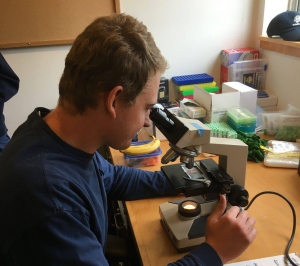 Packed Cell Volume and Total Protein tests to measure how many blood cells and proteins we have in our blood samples. These tests can reveal signs of dehydration, malabsorption, liver disease, hemorrhaging, and a variety of other abnormalities in an animal. We also measure the number of white blood cells in our blood samples by using hemocytometers, which are similar to microscope slides with etched grids, that can help determine presence of infection. After lab tests are completed and recorded, we pack our stuff up and head home for the day for a much needed shower and maybe some blood collection tube labeling over dinner!
Packed Cell Volume and Total Protein tests to measure how many blood cells and proteins we have in our blood samples. These tests can reveal signs of dehydration, malabsorption, liver disease, hemorrhaging, and a variety of other abnormalities in an animal. We also measure the number of white blood cells in our blood samples by using hemocytometers, which are similar to microscope slides with etched grids, that can help determine presence of infection. After lab tests are completed and recorded, we pack our stuff up and head home for the day for a much needed shower and maybe some blood collection tube labeling over dinner!
It’s a long, busy day when working with Blanding’s turtles but the saying that goes “if you enjoy what you do, you’ll never work a day in your life” rings especially true when you get to be around these little guys.
